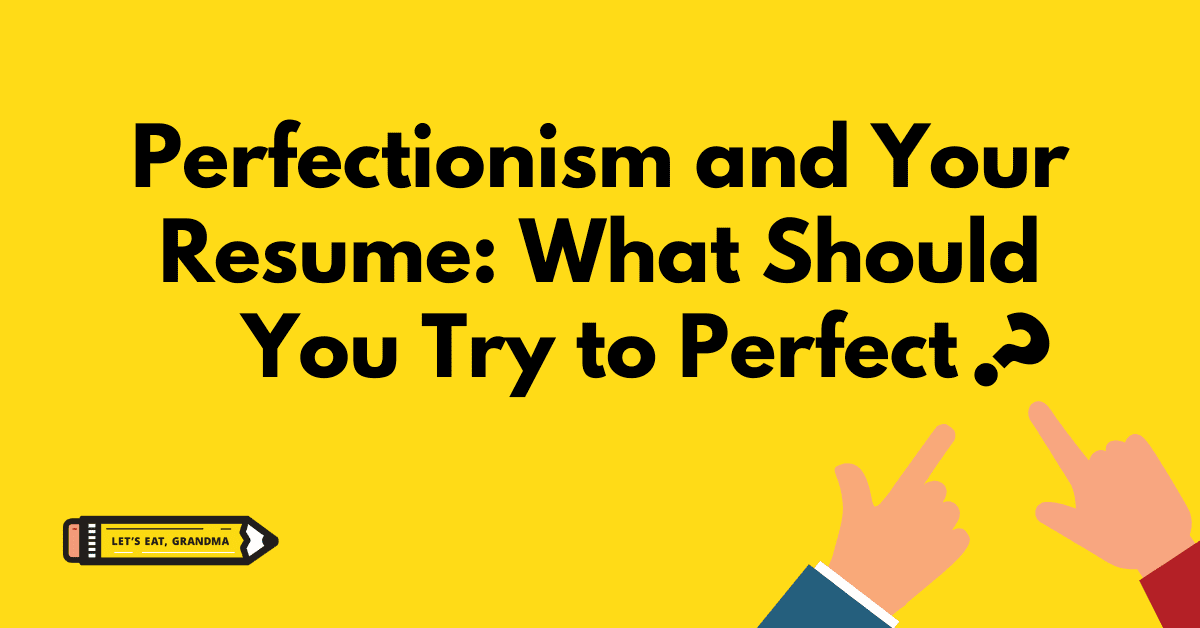Perfectionism and Your Resume: What Should You Try to Perfect?

Are you a perfectionist? It’s important to take time and care in revising your resume, but it’s also important to know when to stop. Here are our recommendations for where the bulk of your time should be spent.
By: Grace Mitchell | Contributor for Let’s Eat, Grandma
Are you rewriting your resume for the 27th time? Fixating on the pros and cons of Helvetica versus Helvetica Neue? Spending hours googling synonyms for “developed”?
If any of these scenarios resonated with you, chances are you – like many of your fellow job-seekers – are dealing with perfectionism. And if that perfectionism is causing you to obsess over the minutiae of your resume, there’s a huge chance it’s working against you.
Want more job search tips? Sign up for our newsletter!
But what if we told you there was another way? Last month, our Career Warrior podcast featured Anna Lieber, who spoke on how to make perfectionism your friend. She discussed her own struggles with perfectionism and how she has re-channeled this tendency to work for her.
Lieber said, “Perfectionism can be good if you are trying to be perfect … in things that really matter for you, matter to you, and change the quality of your life significantly.” She devotes the bulk of her attention to the most essential elements of her work. The little things, though, she’ll do, check once, and move along.
So how can we apply this strategy to your struggles with writing your resume? What are the areas to really spend time on, and what are the areas that don’t need to be perfect?
What Not to Obsess Over
Choosing the perfect font
Font choice is a tempting place to get stuck. There are so many out there, and using the wrong one may land your resume in the trash. But is there really a “perfect” font choice? A recent article revealed what some recruiters consider the best fonts to use in your resume. If you look at the list, though, you’ll find all these fonts are easy to read, and common across versions of Microsoft Word. While there are plenty of fonts that would be a bad idea to use (please don’t submit your resume in comic sans), as long you’re following those two criteria, your font is good enough.
Getting tons of ATS keywords in
If you’ve heard of Applicant Tracking Systems, you may be fixating on how to “appease the robots.” Remember, though, the ATS doesn’t actually decide if you’re hired. A person does. And if your resume is too jam-packed with keywords to be readable, your efforts will be in vain. Yes, you need to include keywords from the job description, but don’t cram them in to meet some non-existent percent. Generally speaking, including the 5-10 most important keywords from the job description is enough.

When it comes to your resume, some elements are worth obsessing over more than others. Photo by Tim Gouw on Unsplash.
Finding an out-of-the-box design
Maybe you’re spending your energy trying to prove to the hiring manager that you’re fun and creative. They’re getting so many resumes, after all, and giving yours some visual pizazz could be the way you get noticed! We love aesthetics as much as anyone, but, unless you’re applying in the entertainment industry, “fun” is unlikely to be the primary quality you want to convey.
You don’t need infographics to stand out; in fact, including them is likely to backfire. Recruiters want to easily find your qualifications for the job more than they want to be entertained, and a fancy design makes that harder for them. Use a design that’s easy to read, and move along to the more important elements!
Showing personality with jokes, or finding or an overly conversational tone to “stand out”
Since you don’t know the hiring manager (yet), you have no way to know if they’ll appreciate your sophisticated taste in meme references or not. Save your best material for the office, and focus on writing a resume that will get you there.
Instead of weighing the value of minor aesthetic choices, devote that strong perfectionist energy to what really matters: your content!
What Deserves Serious Attention
Crafting an excellent summary of qualifications
Hooking in your reader at the top of the resume is crucial. Your summary of qualifications concisely tells the hiring manager what you’ve accomplished in your work so far, so they can see right away if you’re a candidate who could be a good fit. Since it’s near the top of your resume, it’s likely that this will be the hiring manager’s introduction to you and what you would bring to the table. So put some effort into this section to leave a good first impression.
Making sure every bullet is an accomplishment …
No matter what industry you’re in, a list of 4-5 results-oriented, accomplishment-based bullet points for each job entry is a must. So, perfectionists, take a look. Are you listing job duties instead of accomplishments? If you’re having time differentiating between the two concepts, a trick is to use the car (challenge-action-result) method to think about your work. What challenge did your work present? What action did you take to meet that challenge, and what was the result?
… with a metric and result
Once you’ve identified your achievements, you want to present them in a clear, impactful way. Our resume writers follow a four-part formula to craft bold bullet points. Here’s what that looks like:
(1) Active Verb + (2) Contribution and Skills Used + (3) Result
(4) Add Metrics to Contribution and/or Result
Perfectionists should pay particular attention to part four of the formula: Metrics. The most memorable resumes include metrics that demonstrate exactly how each achievement affected the company.
For example, say you worked in a call center where service was slow. However, you provided enhanced training to staff and collaborated with management to clarify some unclear company policies, and your actions led to a decrease in customer wait time from 25 to 7 minutes. Let’s see that in a results-oriented, accomplishment-based bullet point:
- Provided enhanced staff training and collaborated with management to reduce customer wait time from average of 25 to 7 minutes.
Now the hiring manager knows not just what you did on the job, but what you did that sets you apart from others doing the same job.
Using powerful language
Pick dynamic, varied adjectives and verbs. Beginning each bullet point with a strong action verb will make it easier for you to keep your bullet points concise and results-oriented, and this powerful language keeps the reader engaged as well! If you’re having trouble coming up with verbs to use, this Indeed article has 195 to make your accomplishments shine.
Getting the right length
You’ve probably heard that your resume should never exceed one page, but that isn’t actually a hard and fast rule. Instead, focus on making your resume “long enough to cover the subject but short enough to be interesting.” Make sure every word matters, whether you’re new to the job search and have half a page of experience or if you’re 20 years into your career struggling to fit that experience within two pages. Whatever the case, the length of your resume should reflect the amount of relevant work experience you have, which brings us to the final point to hone in on in your resume.
Making sure you don’t include irrelevant jobs or info
The law firm you’re hoping to get into doesn’t need to know that you’re a certified bike technician. Trust us.
Take the time to scrutinize the contents of your resume. Ask yourself: Is this relevant to the job I’m applying to? Is there a way to translate this skill so that there’s a more obvious connection, or should I omit it altogether? Your resume should be easy to skim. The more irrelevant material there is, the more likely the hiring manager is to miss more important details.
In Conclusion
Remember: content over aesthetics. Focus your time and attention on words and phrasing, and definitely make time for a final proofread. But once you have a final product, don’t waste valuable time fine-tuning tiny details – earlier applicants have a better chance of getting an interview.

Photo by Brett Jordan on Unsplash.
Want more job search tips sent straight to your inbox? Sign up for our newsletter here:
Better Resume.
Satisfying Career.
Happier You.
